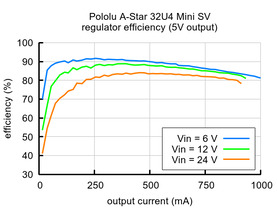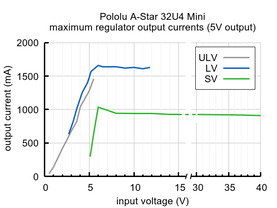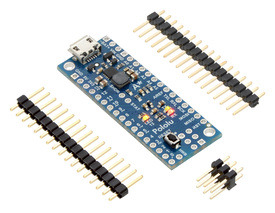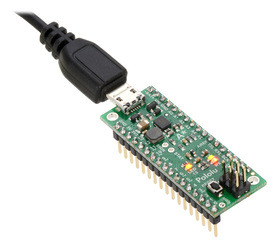Prices incl. VAT plus shipping costs
Ready to ship today,
Delivery time appr. 1-3 workdays
- Order number: Pololu-3145
- Manufacturer product ID: 3145
The A-Star 32U4 Mini SV is a programmable module based on the ATmega32U4 from Microchip (formerly Atmel). Unlike competing products, it has an on-board switching step-down regulator that allows it to be powered efficiently from a 5 V to 40 V supply. This compact 1.9″ × 0.7″ board breaks out all 26 of the microcontroller’s I/O pins (of which 7 can be used as PWM outputs and 12 as analog inputs), and loading programs is made easier by a Micro-USB interface and a preloaded Arduino-compatible bootloader.
The Pololu A-Star 32U4 Mini boards are general-purpose programmable modules based on the ATmega32U4 AVR microcontroller from Microchip (formerly Atmel), which has 32 KB of flash program memory, 2.5 KB of RAM, and built-in USB functionality. The A-Star (abbreviated A*) adds a number of onboard features to support the microcontroller and make it easier to work with, including a 16 MHz crystal, a USB Micro-B connector, an in-system programming (ISP) header, a reset button, and three indicator LEDs.
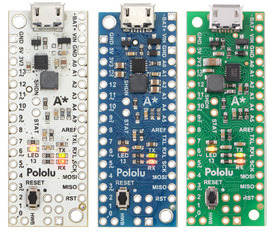 |
| A-Star 32U4 Mini ULV, LV, and SV. |
|---|
Each A-Star 32U4 Mini contains a switching regulator that efficiently produces 5 V from an external voltage source to power the microcontroller. Three different versions are available, covering a wide range of input voltages:
- A-Star 32U4 Mini ULV: 0.5 V to 5.5 V
- A-Star 32U4 Mini LV: 2.7 V to 11.8 V
- A-Star 32U4 Mini SV: 5 V to 40 V
A robust power selection circuit enables seamless transitions between regulator power and USB power, and overcurrent and reverse-voltage protection help safeguard the board against accidental damage.
All 26 general-purpose I/O lines on the ATmega32U4 are accessible on the A* 32U4 Mini; 7 of these are usable as PWM outputs and 12 are usable as analog inputs. The board measures 1.9″ × 0.7″, the same size as an Arduino Micro, and features a pair of mounting holes sized for #2 or M2 screws (not included). Its 0.1″ pin spacing makes the A* easy to use with solderless breadboards, perfboards, and 0.1″-pitch connectors.
Our comprehensive user’s guide provides the basics you need to get started with the A-Star as well as detailed technical information for advanced users.
This product requires a USB A to Micro-B cable (not included) to connect to a computer.
Features
- Dimensions: 1.9″ × 0.7″ (1.95″ × 0.7″ including USB Micro-B connector)
- Programmable 16 MHz ATmega32U4 AVR microcontroller
- 32 KB flash (4 KB used by bootloader, leaving 28 KB available for user program by default)
- 2.5 KB SRAM
- 1 KB EEPROM
- Native full-speed USB (12 Mbps)
- Preloaded with Arduino-compatible bootloader (no external programmer required)
- All I/O lines from the ATmega32U4 broken out in a compact package
- 26 general-purpose I/O pins available along the sides of the board
- 7 pins can be configured as hardware PWM outputs
- 12 pins can be configured as analog inputs
- 3 user-controllable LEDs
- Reset button
- Can be powered from USB or from an external source:
- ULV: 0.5 V to 5.5 V
- LV: 2.7 V to 11.8 V
- SV: 5 V to 40 V
- Switching regulator enables efficient operation
- Power selection circuit allows for seamless switching between power sources and provides overcurrent protection
- Reverse-voltage protection on external power inputs
- Precision 16 MHz crystal
- 6-pin ISP header for use with an external programmer
- Comprehensive user’s guide
Details for item #3145
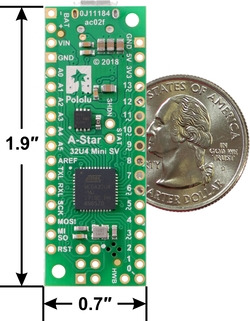 |
| A-Star 32U4 Mini SV, bottom view with dimensions. |
|---|
This version, the A-Star Mini SV, can be powered from a 5 V to 40 V external source. The input voltage is regulated to 5 V by an 800 mA ISL85418 switching step-down (buck) converter from Renesas (which acquired Intersil). (We also make standalone regulators based on the 500 mA and 1 A versions of this integrated circuit.)
As shown in the left graph below, the SV’s switching regulator has an efficiency – defined as (Power out)/(Power in) – of 80% to 95% for most combinations of input voltage and load.
|
|
The A-Star’s components, including the microcontroller and LEDs, draw 30 mA to 40 mA in typical applications. The rest of the regulator’s achievable output current, which depends on input voltage as well as ambient conditions, can be used to power other devices. The green line in the right graph above shows the output currents where the regulator’s output voltage drops below 4.75 V. These currents are close to the limits of the regulator’s capability and generally cannot be sustained for long periods; under typical operating conditions, a safe limit for the maximum continuous regulator output current is approximately 800 mA.
The dropout voltage of a step-down regulator is defined as the minimum amount by which the input voltage much exceed the regulator’s target output voltage in order to assure the target output can be achieved. As can be seen in the graph below, the dropout voltage of the Mini SV’s regulator increases approximately linearly with the output current. For light loads where the dropout voltage is small, the board can operate down to 5 V. However, for larger loads, the dropout voltage should be taken into consideration when selecting a power supply; operating above 6 V will ensure the full output current is available.
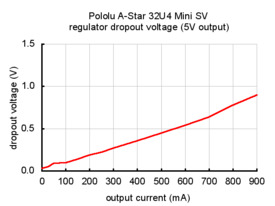 |
Note: Batteries can have much higher voltages than their nominal voltages when fully charged, so be careful with nominal voltages above 24 V. A 36 V battery is not appropriate for this product.
This newer version (ac02f) of the A-Star 32U4 Mini SV replaces the original version (ac02c). The new version uses an improved 5 V regulator that can deliver more current (800 mA vs 500 mA) and operates to 40 V instead of 36 V. The easiest way to distinguish between the two versions is via the silkscreen on the side of the board opposite the USB connector, where the original version is labeled ac02c and the new version is labeled ac02f. The new version also uses an ENIG finish, so the plating on the exposed copper looks gold, and it has unplated mounting holes.
Arduino compatibility
The A-Star 32U4 ships with a preloaded Arduino-compatible bootloader (which uses 4 KB of flash memory, leaving 28 KB available for the user program). We provide a software add-on that enables the board to be easily programmed from the Arduino environment.
The A-Star 32U4 Mini boards use the same microcontroller as the Arduino Leonardo and Arduino Micro and run at the same frequency, and they are the same size as the Arduino Micro, but they offer a number of advantages over these other ATmega32U4-based boards. Most notably, their efficient switching regulators cover a wide range of input voltages, opening up new possibilities for powering projects built around Arduino-compatible microcontroller boards. Another advantage is the power selection circuit based on the TPS2113A power multiplexer from Texas Instruments, which allows safe, seamless power switching between USB and an external source without losses from passive components like fuses or diodes along with the ability to monitor and control the selected power source. Additionally, the A* 32U4 Mini breaks out a few additional pins from the ATmega32U4 microcontroller that are not exposed on the Arduino Micro or Leonardo, and it features larger, more convenient mounting holes than the Arduino Micro.
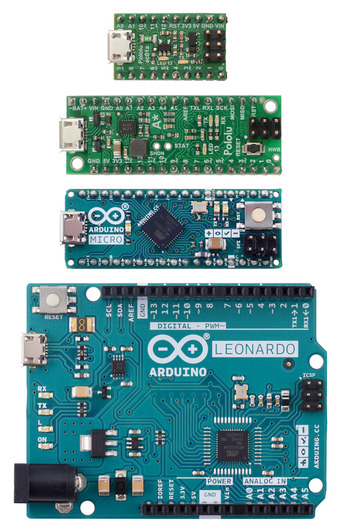 |
| Pololu A-Star 32U4 Micro, Pololu A-Star 32U4 Mini SV, Arduino Micro, and Arduino Leonardo. |
|---|
Pinout
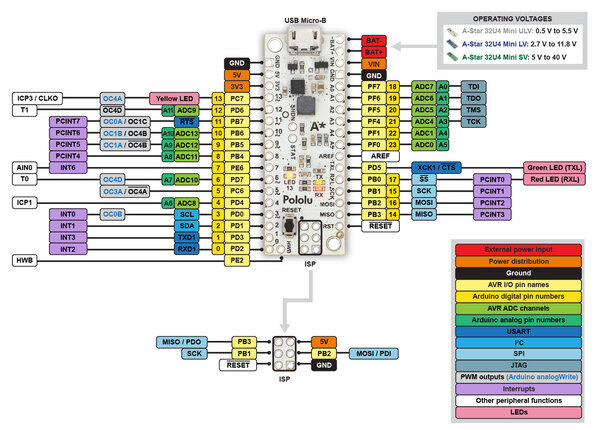 |
This diagram identifies the I/O and power pins on the A-Star 32U4 Mini (even though it shows the ULV version, it applies to all three A-Star Mini boards); it is also available as a printable PDF (269k pdf). For more information about the ATmega32U4 microcontroller and its peripherals, see Microchip’s ATmega32U4 documentation.
Printed on the A* circuit board are indicators that you can use to quickly identify each pin’s capabilities: a triangle next to the pin means it can be used as an analog input, and a square wave symbol under the pin number means it can be used as a PWM output.
The A-Star 32U4 Mini can either be powered directly from the USB 5 V supply or from an external voltage source, which is regulated to 5 V by its onboard regulator, and the board’s power selection circuit enables automatic, uninterrupted transitions between the two power sources. When the A-Star is powered through an external power supply connected to the BAT+ and BAT- pins, its reverse-voltage protection circuit helps prevent it from being damaged by accidentally-reversed power connections, and the VIN pin can be used as an output to supply reverse-protected power to other devices. Alternatively, the external supply can be connected directly between VIN and GND, bypassing the reverse-voltage protection.
The A-Star 32U4 user’s guide discusses the board’s features in more detail.
Included hardware
A pair of 1×17-pin breakaway 0.1″ male headers is included with the A-Star 32U4 Micro, which can be soldered in to use the board with perfboards, breadboards, or 0.1″ female connectors. Also included is a 2×3 header that can be installed to allow external programming of the microcontroller through the AVR ISP interface, such as with our USB AVR programmer. The board has two mounting holes that work with #2 and M2 screws (not included).
|
|
Dimensions
| Size: | 0.7″ × 1.95″ × 0.23″ |
|---|
General Specifications
| Processor: | ATmega32U4 @ 16 MHz |
|---|---|
| RAM size: | 2560 bytes |
| Program memory size: | 32 Kbytes |
| Motor channels: | 0 |
| User I/O lines: | 26 |
| Input voltage range: | 5 V to 40 V (SV) |
| Minimum operating voltage: | 5 V |
| Maximum operating voltage: | 40 V |
| Maximum output current: | 800 mA |
| Logic voltage: | 5 V |
| Reverse voltage protection?: | Y |
| External programmer required?: | N |
Notes:
- Without included optional headers. This measurement includes the USB Micro-B connector, which extends 0.05″ past the edge of the PCB.
- Without included optional headers.
- Note that 4 KB of the MCU's 32 KB of flash memory is used by the pre-installed USB bootloader. All 32 KB is available when programming via the ISP header rather than the bootloader.
- For light loads. The regulator's dropout voltage increases approximately linearly with the load, from a few millivolts at no load up to around 0.6 V at 500 mA.
- Available current depends on input voltage, current consumed by the board, ambient conditions, and regulator topology. See product documentation and performance graphs for details.
- On Bat+ (LV, SV) or Bat- (ULV).








